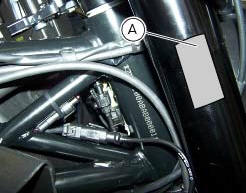
Ducati Diavel Service Manual: Steering angle adjustment
Loosen the nuts (17) and adjuster screws (16) on both sides of the bottom yoke.

Use a 6 to 6.5 Mm spacer (a) fitted to the fork outer tube, or use a gauge.

Turn the front forks to the right until the spacer (a) is seated against the frame top tube.
Tighten the adjuster screw (16) to bring it into contact with the stop on the steering head.
Apply threadlocker to the thread of nut (17). Hold the adjuster screw (16) firm and tighten the nut (17). Turn the forks to the opposite side: and repeat the process to adjust the other dowel and tighten the relative lock nut.

Once adjusted, set handlebar completely turned right and ensure that the gap between front brake line and lower frame trellis is at least 1 mm. If it is not so, decrease steering angle by working the right-hand adjuster.

 Adjusting the steering head bearings
Adjusting the steering head bearings
Note
To adjust the steering bearing clearance, follow what is described in
sect. 4 - 3, Adjusting the steering head bearings.
If the problems found are not solved, check the wear of steering beari ...
 Removal of the steering head components
Removal of the steering head components
Note
All parts fitted to the top and bottom yokes, including the wiring and
control cables, can remain on the motorcycle
provided they do not hinder the following operations.
Loosen the screw ...
Other materials:
Reassembly of the control unit
Insert the control unit (4) into the protecting sheath (5) and position it on
the airbox.
Position the relay supporting bracket (2) by starting and tightening the
screws (1) to a torque of 6 nm +/- 10% (sect. 3 -
3, Frame torque settings), and connect the control unit connectors (3).
...
Dashboard
Note
The dashboard is supplied as a single component; its internal components
cannot be renewed separately.
Important
Whenever the dashboard is renewed, the ignition key programming procedure
must be repeated.
Loosen the nuts (2) to remove the master dashboard (1) from its seat and
disconn ...
Refitting the rear mudguard
Place the rear mudguard (8) on the swingarm, fitting the screws (9) with
recommended threadlocker.
The screw (9) in the bottom hole of the rear mudguard (8) must be installed with
the washer (r).
Tighten the screws (9) to a torque of 5 nm +/- 10% (sect. 3 - 3, Frame torque
settings).
...